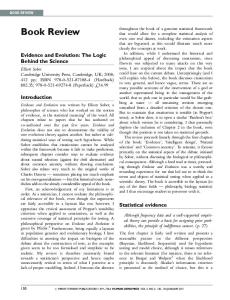Science behind AI: the evolution of trend, mobility, and collaboration
- PDF / 2,199,656 Bytes
- 21 Pages / 439.37 x 666.142 pts Page_size
- 72 Downloads / 302 Views
Science behind AI: the evolution of trend, mobility, and collaboration Sha Yuan1,3 · Zhou Shao2,1 · Xingxing Wei4 · Jie Tang1 · Wendy Hall5 · Yongli Wang2 · Ying Wang6 · Ye Wang6 Received: 29 June 2019 © Akadémiai Kiadó, Budapest, Hungary 2020
Abstract In this era of interdisciplinary science, many scientific achievements, such as artificial intelligence (AI), have brought dramatic revolutions to human society. The increasing availability of digital data on scholarly outputs offers unprecedented opportunities to explore science of science (SciSci). Despite many significant works have been done on SciSci, substantial disciplinary differences in different domains make some insights inadequate within particular fields. One thing standing out is that knowledge concerning the science behind AI is sorely lacking. In this work, we study the evolution of AI from three dimensions, including the evolution of trend, mobility, and collaboration. We find that the AI research hotspots have shifted from theory to application. The USA, which has the largest number of distinguished AI scientists, appeals most to the global AI talents. The brain drain problem of AI scientists is increasingly serious in developing countries. The ties among the AI elites are highly clustered in the collaboration network. Overall, our work aims to serve as a starter and support the development of AI exploring in a visionary way. The related demos are available online in AMiner (https://www.aminer.cn/ai10, https://trend.aminer.org). Keywords Artificial intelligence · Science of science · Trend · Career trajectory · Collaboration
Sha Yuan and Zhou Shao have contributed equally to this article. Sha Yuan and Zhou Shao are co-first authors. * Jie Tang [email protected] 1
Department of Computer Science and Technology, Tsinghua University, Beijing, China
2
Nanjing University of Science and Technology, Nanjing, China
3
Beijing Academy of Artificial Intelligence, Beijing, China
4
Beihang University, Beijing, China
5
University of Southampton, Southampton, UK
6
Exchange, Development and Service Center for Science Technology Talents, The Ministry of Science and Technology of China, Beijing, China
13
Vol.:(0123456789)
Scientometrics
Introduction In this era of interdisciplinary science, many scientific achievements, especially in artificial intelligence (AI), have brought dramatic revolutions to human society. With the rapid development and application of AI, it has taken the focus attentions from both industry and academia. The AI field is a broad discipline that draws upon computer science, mathematics, artificial psychology, linguistics, and many others. Although AI is difficult to define precisely, a machine is considered to have intelligence if it passes the Turing test. Thus, artificial intelligence usually refers to an artificial machine or program that simulates human thinking. It exhibits similar intelligent behavior to the human mind. There is no doubt that progress in AI has accelerated the information construction of
Data Loading...











